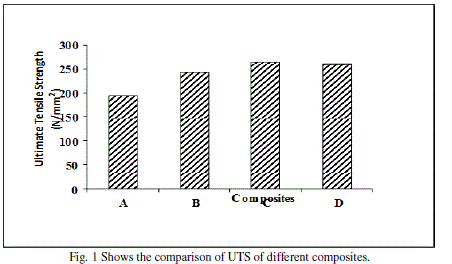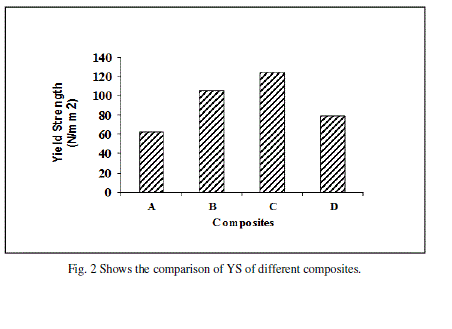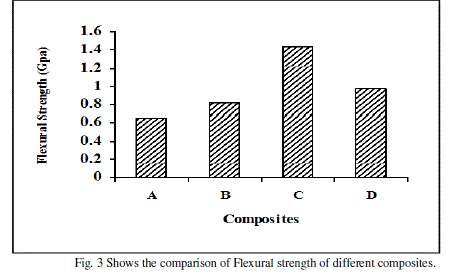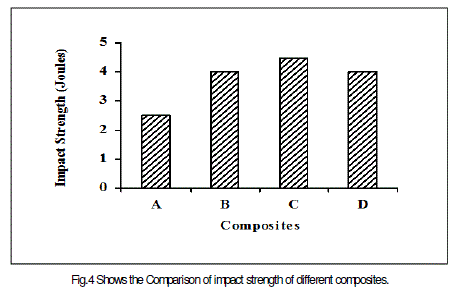ISSN ONLINE(2319-8753)PRINT(2347-6710)
ISSN ONLINE(2319-8753)PRINT(2347-6710)
M. N. Channapagoudra1, Ajith G Joshi2, Sunil Thaned3, Mahantesh Patil4
|
| Related article at Pubmed, Scholar Google |
Visit for more related articles at International Journal of Innovative Research in Science, Engineering and Technology
Polymer matrix composites are emerging as promising materials in many engineering materials. In the present study, mechanical behaviour of glass/epoxy composites with varied volume fraction of hematite filler has been investigated. The composites were prepared by hand lay-up technique. The mechanical properties viz. tensile behaviour, flexural behaviour, impact behaviour, hardness behaviour are investigated. The tensile test and flexural test has been carried out using Universal Testing Machine, impact test has been carried out using Charpy method, hardness test has been done by BHN method. The objective was to investigate influence of hematite filler on mechanical characteristics of glass/epoxy composites. The obtained results revealed that hematitie filled composites exhibited better than unfilled glass/epoxy composites. The 10% hematite filled glass/epoxy composites has shown superior to other studied composites.
Keywords |
| Composite materials, mechanical properties, hand lay-up technique, hematite filler |
INTRODUCTION |
| Polymers and their composites are gaining wide scope in many engineering applications such as navel applications, aerospace structures, spaceship structures, gears because of high modulus and high toughness, resistance to corrosion, good tribological properties and so on [1]. However polymeric composites are susceptible to mechanical damage, when subjected to tension, compression and flexural loads resulting in interlayer delamination [2]. Thus nowadays lot of research is going towards enhancing the mechanical properties of the composites. Works are reported mainly enhancing the properties by varying the fiber volume fraction, orientation and so on [3]. Recent development in this field is improving mechanical properties by adding secondary reinforcements called fillers. |
| Carbon fibers and E-glass fibers are common type of reinforcements found in many of the engineering applications due to its best characteristics available. As with resin development; the pace of fiber development has accelerated since the 1950s with the introduction of E glass, R glass, S glass, and special acid and alkali-resistant glass. Glass fiber has been a major reinforcement for the FRP industry, but the drive for lighter, stronger, and stiffer structures has seen the introduction of carbon and poly-aramid fibers [4]. In case on thermoset polymeric matrices, epoxy are most widely as structural applications and also in other industrial applications due to its high resistance to corrosion and chemicals, good thermal, mechanical properties [5, 6]. |
| Paiva et al. [2] reported improving the toughness of the matrix materials can enhance the mechanical properties, which may be due to interface between the reinforcements and matrix. Aramide [3] et al. obtained the results that increase in fiber volume fraction can lead to increase in elastic modulus and extension to break till certain threshold value and further increase in fiber volume implies in decrease in the same properties. However hardness increases with increase in fiber volume but strain decreases. Mingla and Chawla [7] concluded that increase in fly ash content in epoxy resin can improve the compressive strength of composite and also it can be further enhanced along with impact strength by introducing glass fiber in composites. |
| Djoković, and Nedeljković [8] has found that increase in hematite filler content lead to increase in elastic moduli and magnitude of stress relaxation of the composites. Good amount of works has reported on mechanical behaviour of glass/epoxy composites and filled with different fillers such as SiCp, Gr, fly ash and so on. However it can be noted that mechanical properties of glass/epoxy composites filled with hematite filler is not being evaluated sufficiently though it is one of the naturally available types of filler material. |
| In this regard, the current work has been concentrated towards the mechanical properties such as tensile, hardness, impact and flexural properties of glass/epoxy composites with hematite filler. The aim was to evaluate mechanical properties glass/epoxy composites with varied volume fraction of hematite filler content. |
II. EXPERIMENTAL DETAILS |
A. MATERIALS |
| The matrix material used was medium viscosity epoxy resin (LAPOX L-12) and room temperature curing polyamine hardener (K-6). This matrix was chosen, since it provides good resistance to alkalis and good adhesive properties. The reinforcement material employed was 7-mil E-glass fiber. The filler used was hematite passed through 75-150μm. The details of the material combination and percentage of filler materials are given in Table.1. |
 |
| Epoxy resin is chosen since it provides good resistance to alkalis and good adhesive properties. Glass fiber is chosen as the reinforcing material since it has good strength to weight ratio and also it is cheap. |
B. SPECIMEN PREPARATION AND TEST DETAILS |
| A hand lay-up technique was adopted to prepare the glass-epoxy composites with filler. To prepare glassepoxy with hematite filler composites, filler is mixed with a known amount of epoxy resin. The laminate was cured at ambient conditions for a period of about 24 hours. The size of the laminates prepared were 250mm X 250mm X 3mm. The composites are fabricated and cured as reported by Suresha et al. [9] and basavarajappa et al. [10]. The cured materials are cut to yield test specimens in accordance of ASTM standards. Tensile test has been conducted according to ASTM D 3039, Flexural test has been conducted to ASTM D 2344, Impact test has been conducted ASTM E23 and Hardness has been measured in terms of B.H.N. value in accordance of ASTM E10. |
III. RESULTS |
| In the current work, the tensile, flexural, impact and hardness properties of glass/epoxy composites filled with varied volume fraction of hematite filler was evaluated. The main aim was to find the influence of hematite filler and by variation of its volume fraction on mechanical properties of glass/epoxy composites. The results obtained are discussed further in this section. |
A. TENSILE PROPERTIES |
 |
| The comparison of tensile test results obtained for unfilled glass/epoxy and filled with 5%, 10%, and 15% volume fraction hematite filler is shown in Fig. 1 to Fig. 2. The results revealed that tensile strength of glass/epoxy composites filled with hematite filler is greater than the unfilled composites. It can also be observed that increase in filler volume fraction resulted in increase in tensile strength of the composite till 10% filler content composites and further increase in filler volume exhibited detrimental effect. This may be due to the reason that weak bonding strength between the interfacial/matrix in high filler content composites compared to low filler content composites (≤10%). Thus it finds addition of 10% hematite filler to the glass/epoxy composites is optimum to get better tensile properties, while the composites are fabricated by hand lay-up technique. |
B. FLEXURAL STRENGTH |
| Flexural behaviour of polymer and their composites is of prime interest to designers as well as polymer and their composite manufacturers. Flexural strength is the ability of the material to withstand bending forces applied perpendicular to its longitudinal axis. The stresses induced by the flexural load are a combination of compressive and tensile stress. |
| The comparison of flexural test (3-point bending test) results obtained for unfilled glass/epoxy composites and filled with 5%, 10% and 15% volume fraction hematite filler is as shown in Fig. 3. The results reveals that flexural strength of glass/epoxy composites filled with hematite filler is greater than the unfilled glass/epoxy composite. Increase in filer content till 10% filler content lead to increase in flexural strength of the composites whereas further increase in filler decreased its flexural strength. This may be due to the fact that further increase in filler content has increased it brittleness, thus failed to withstand bending load of higher magnitude. |
 |
C. IMPACT STRENGTH |
| In composites with notch along the laminates, crack propagation takes place through fiber at certain extent and immediately followed by the matrix present between laminates and vice-versa. During this phenomenon, fiber offers extra resistance for crack propagation upto certain instant and increases the impact strength. However crack propagation is through the matrix rather than the fibers in the laminates with notch across the laminates. Due to the embrittlement of the matrix during crack propagation reduces the impact strength for the composites with notch across its laminates. |
| Fig. 4 reveals the variation of impact strength with variation of filler content in the glass/epoxy composites. There is an increase in impact strength due to the addition of hematite filler till 10% volume fraction. Brittleness of the composites having greater than 10% hematite again accounts for the decrease of impact strength with the increase of filler content in composites. Addition of hematite particles increases its strength as discussed earlier, thus crack propagates with minimum energy. Hence there was increase in impact strength due to addition of fillers. |
 |
D. HARDNESS |
| The comparison of Brinell hardness test results obtained for different studied composites is shown in Fig. 5. The figure reveals that there was an increase in B.H.N. value with the increase in filler content and was higher than unfilled glass/epoxy composite. This is due to addition of hard ceramic filler content in the matrix layer which is at the surface. The hard ceramic reinforcement resists the plastic deformation, which is usually done by some indentation. This resistance is further increased by increasing hard reinforcement volume fraction in the composites. Thus 15% hematite filler content composite has shown the highest hardness value than other studied composites. |
 |
IV. CONCLUSIONS |
| Following were the conclusions drawn from the current study. |
| 1. Glass/epoxy composites with hematite filler has exhibited better mechanical properties than unfilled composite. |
| 2. Increase in filler content has proved to be beneficial at filler volume fraction till 10%. Further increase in filler content has detrimental effect due to improper bonding between the matrix and the filler interface and increased embrittlement of the composites. |
| 3. However there was increase in hardness of the composites with the increase in the filler content even till 15% (highest volume fraction of filler in the study) of filler content, which may due to reinforcement of hard ceramic particles. |
| 4. Though the highest B.H.N. value was found to be 15% filler content glass/epoxy composite, the optimum filler content can be considered to be 10% to get better mechanical properties of glass/epoxy composites. |
| 5. The obtained results reveal that hematite can be considered as potential and promising filler material and as secondary reinforcements in polymer matrix composites. |
References |
|